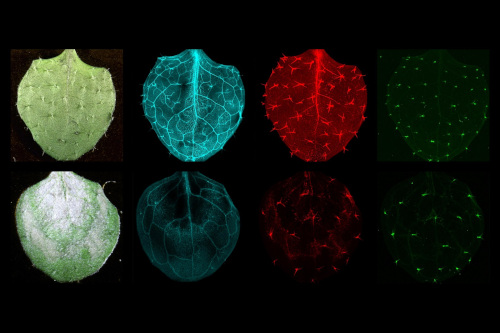Study Sheds Light on Photosynthesis in Iron-Low Leaves
10/05/2021

Top row, leaves of wild type Arabidopsis thaliana imaged using brightfield (far left) and synchrotron X-ray fluorescence spectrometry to show the nutrient distribution of potassium (blue), calcium (red), and iron (green). Bottom row, the same imaging techniques used on light-bleached mutant leaves. [Reprinted from Akmakjian, G.Z., Riaz, N., and Guerinot, M.L. 2021. Photoprotection during iron deficiency is mediated by the bHLH transcription factors PYE and ILR3. PNAS, 118 (40) e2024918118.]
Researchers have identified how iron-deficient plants optimize photosynthesis to protect themselves from absorbing too much light, according to a study published in Proceedings of the National Academy of Sciences.
Iron deficiency has many adverse effects on photosynthesis, which is not surprising given that 90% of foliar iron is found in the chloroplast. Although many iron-sparing mechanisms have been documented, a mechanistic understanding of how chloroplasts adapt to iron deficiency was lacking.
The study demonstrated that the bHLH transcription factors ILR3 and PYE are required for photoprotection during iron deficiency. Changes in chloroplast morphology under the control of these transcription factors prevents the production of harmful reactive oxygen species and allows for repair of photosystem II.
Understanding how plants adapt the photosynthetic machinery during iron deficiency may enable optimization of plant growth in soils where iron is not bioavailable.
Related Links
- BER resource: Center for BioMolecular Structure
- Feature story: Study Sheds Light on Photosynthesis in Iron-Low Leaves
References
Akmakjian, G.Z., Riaz, N., and Guerinot, M.L. 2021. Photoprotection during iron deficiency is mediated by the bHLH transcription factors PYE and ILR3. PNAS, [DOI: 10.1073/pnas.2024918118]
